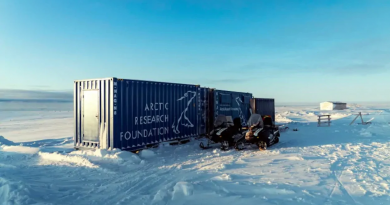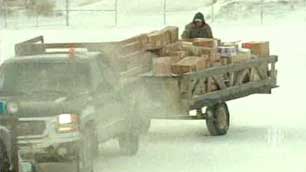EU Seal Ban 2010
The European Union ban on seal products is effective August 20th 2010. A devastating blow to an already impoverished and misunderstood community, Inuit hunters, seamstresses, and artists are feeling the repercussions economically and emotionally
CLYDE RIVER – Joelie Sanguya raises his axe, pauses for a moment, then with a swift blow thrusts it at the frozen seal carcass at his feet. Behind him a chorus of hungry sled dogs fill the Arctic air with a cacophony of excited howling and barking in anticipation of a well-deserved dinner.
Sanguya, an Inuit hunter, artist, filmmaker and an expert musher, continues to work his axe on the frozen carcass, removing the head. Then, bracing the seal body with a hook, he uses a butcher’s knife to cut through the skin and into the blubber cutting it into cubes and tossing it aside. “Don’t step in that. It’ll stick to your boots and stink up the tent when it warms up.”
Having grown up on the north-eastern coast of Baffin Island in the Canadian Arctic, Sanguya had been taught not to waste anything. In the past, he would have carefully removed the adult-sized skin to be cleaned, dried and stretched. His wife or another seamstress would have used the naturally waterproof skin to make an anorak (parka), mittens, or kamiks (traditional Inuit boots). Or, he would have sold it to the village coop. But Sanguya didn’t need new kamiks –what he really needed was money to buy fresh food, ammunition, gas, art supplies, and pay bills.
“I’ll leave the skin and the blubber for crows and Arctic foxes,” Sanguya explains. “Dogs only eat the blubber when they’re really desperate.” He returns to his axe to hack at the skinned animal. Dark maroon in colour, the frozen seal meat shatters like pieces of broken pottery with each blow.
Sanguya had killed the adult ringed seal earlier that day with a clean shot to the head. Seal doesn’t always come easy. The traditional hunt requires scouring dozens of kilometres of sea ice on snowmobiles or dog sleds in search of seal breathing holes – sometimes for several days. Once a breathing hole is found, hunters can wait motionless an hour or more, crouched over the breathing hole in the biting cold, hoping to shoot or harpoon the animal when it comes up to breathe.
Sanguya turns to focus on his hungry dogs. Their barking and howling had become deafening.
Exempt from the ban, but not spared
The ban on seal products was passed in the European Parliament last spring by a vote of 550 to 49. It was adopted following a relentless campaign by animal welfare activists who opposed the commercial seal hunt, calling it inhumane
It officially took effect August 20th this year.
A lawsuit aiming to overturn the ban has been filed in the EU court. A coalition of organizations, including hunter and trapper organizations, the Inuit Circumpolar Council (Greenland) and Inuit Tapiriit Kanatami (representing Nunatsiavut, Nunavik, Nunavut, and the Inuvialuit Settlement) are involved. They say there is no environmental justification for the trade ban, that seal populations are being harvested at reasonable levels, and their hunting practices are humane. Meantime, the Canadian government is challenging the ban before the World Trade Organization.
While the EU ban makes a partial exemption for seal products obtained through the Inuit subsistence hunt, Inuit sealers say the exemption is unclear, and makes little sense anyway, as the ban has completely devastated the seal product market.
“Back in 1983 the Europeans placed a ban on baby harp seals and at that time we were told that the Inuit would be exempt from the ban. However, when the seal market collapsed, even though there was an exemption for the Inuit, the Inuit suffered,” Nunavut Deputy Minister Simon Awa said. “It’s getting more and more difficult for a hunter to put food on the table.”
Economic loss and cultural misunderstanding
The Inuit subsistence seal hunt differs from the commercial hunt that has drawn the ire of animal rights activists.
Unlike Atlantic coast fishermen who hunt harp seals to supply tanneries with skins and pharmaceutical companies with Omega-3 fatty acid-rich blubber, the Inuit hunt ringed seals to feed their communities. The hunting methods are different as well. Inuit hunters mostly use high-powered rifles, not clubs, to kill the seals.
The skins have always been a by-product of the hunt, while providing a much-needed source of income.
–But it’s not only the economic loss that hurts the Inuit. It’s also an emotional issue.
“I just get so mad,” said Arctic College fur design student Lisa Eetuk Ishulutak, fighting tears. “They’re [seals] not in danger or anything. It’s not like we’re keeping them in a farm, giving them fat and then killing them and then making money off them. That’s just how we live.”
Inuit lawyer, seamstress and activist Aaju Peter also feels that the ban attacks the Inuit way of life. “We are being attacked for a skill we have passed down for generations. We were colonized as a people and now we’re being colonized as a culture. They are deciding who is Inuit and how they hunt. They try to divide the Inuit and commercial hunt. ”
“I travel and sit on committees with the east coast sealers. We are not against best practices of harvesting. We depend on this income, whether we are in the Arctic or the East Coast.”
Peter travelled to France in May 2009 to witness the EU vote. Once there, she couldn’t help but think of the Iqaluit families a continent away who would be affected by the ban, feeling completely powerless to fight it.
At the evening dinner for Nunavut visitors, she began to get emotional about the hypocrisy of it all. “We were asked if we wanted to try the specialty, the foie gras. It’s duck that has actually been force fed beyond its limits. It astonished me. What – you’re not supposed to harm animals, but if you’re going to consume them, you can force feed them?”
“What a hypocrisy. At the end of the day I have nothing against raising or hunting animals, but we should all agree that we shouldn’t be misunderstanding one another. ”
Harvesting a land of ice and snow
In a climate where the ground is covered in snow for 10 months of the year, livestock farming and agriculture are impossible. For the Inuit, the hunt is a way of life; a cultural mainstay, a way of living sustainably, and ultimately, of surviving. The Inuit harvest resources that the land and water provide. They rely heavily upon the seal.
With food prices in the Canadian Arctic up to three or four times higher than in the south, (a loaf of bread that costs $2.99 in a major Canadian city like Montreal, Quebec, costs $8.99 in Iqaluit, the capital of Nunavut), seal meat is essential to supplement the Inuit diet. “What is out there on the tundra is my shopping centre, my grocery store; I have to go there to get my food,” Awa said.
He worries that the seal ban is just the opening salvo in a cultural war that has pitted urbanized Westerners against East Coast fishermen and Inuit hunters.
Awa hopes the ban doesn’t set a precedent. “My worst fear is that in addition to the ban on seal skin products in European countries that this ban could have other ripple effects for other wildlife species in Nunavut other than seal,” he said. “That would have a devastating effect on economic opportunities, especially for smaller communities that have unemployment as high as 60 to 80 per cent. Selling seal skin products even though it’s minimal has big implications for a community, for a family that doesn’t have any other income.”
The government of Nunavut has created the Fur Pricing Program to cushion the blow of the seal market collapse. Under this program, Nunavut authorities purchase about 6,000 to 9,000 skins each year, providing about $500,000 in income for hunters, significantly less than they would have received if the seal skin market hadn’t collapsed.
Awa expresses hope that new markets will open up. “We are working very hard to find other markets. For example, we are definitely interested in looking at China, and we are also definitely looking at Russia and other non-European countries and we’re also going to be looking seriously within Canada.”
Canadian support despite protest
When Canadian Senator Celine Hervieux-Payette organized a luncheon for Canadian MP’s to show solidarity with hunters fighting the EU seal ban this March, it made headlines across the nation.
Hervieux-Payette hopes the Canadian government will continue to get the message out that the European Community should not be dictating who hunts what in Canada. “We don’t need permission from the European Community –we’re talking about trade, we are before the World Trade Organization and the seal being hunted here and the seal being hunted on the Atlantic coast it’s exactly the same business.”
But fighting the animal rights activists hasn’t been easy. Early this year, Fisheries Minister Gail Shea got a protest pie in the face and was told “Shame on you” two weeks after her return from the China Fur and Leather Products Fair. Last year Governor-General Michaëlle Jean was described as “barbaric” by European papers for eating seal heart during a visit to Nunavut.
The issue causes confusion. According to a poll conducted by the governments of Nunavut, Newfoundland, Quebec and Nova Scotia in partnership with the Fur Institute of Canada, 75% of Canadians believe that animal welfare is either somewhat or completely respected by seal hunters, and 82% support a sustainable, humane Inuit seal harvest. – But only 34% of Canadians knew that despite the Inuit exemption on the ban, trade in Inuit harvested seals has decreased markedly.
Ishulutak thinks that animal rights campaigners and EU MP’s simply need a crash course in the reality of life in the Arctic. “I would take them camping,” she said. “I just want to show them how we live and how my ancestors lived, how us Inuks live up here. During winter and cold days we do need seal to survive still.
“They’re not in danger or anything.”
-With additional reporting by Ingrid Hein, Radio Canada International



